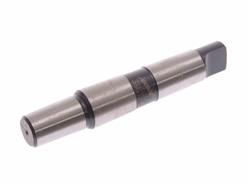All excellent ideas, thanks. Although, I have done some of those already described, I have not however used any kind of reamer yet to polish the taper. Yeah the surface rust wouldn't really be a huge issue I suppose and has not been other than I just replaced some bearings on this lathe. I am aiming to polish the spindle MT well enough to enable me to remove some of my tooling without having to use a mallet.
I currently have no issue with removing any of my solid tapers with a hand driven knockout bar.
(I think this is typical) However, when using tapers which require a drawbar, upon time of removal - they require a gentle, single strike to threaded knockout tool in order to remove.
(That seems wrong - especially if you are not over tightening the drawbar - but I just had another thought - are you sure this tooling is right?) most #2 MT shafts are plain but - there are ones like this;
This is obviously a drill chuck (#2 MT / Jacobs taper) but it was the first picture I found - with that center relief it makes it easier to remove the shaft - you could add this to one of your draw-bar chucks to see if it makes a difference - now as Mike so rightly points out - you need the friction to drive the wood you are turning - so you don't want to sacrifice it all - but if memory serves - the reason you are looking at this is because you were changing bearings in your lathe head stock. It is not right of me to Arm-chair mechanic, but I think you thought you might be beating on them right?)
Last thought and I will quit - you mention later in this post that you "use reamers all the time with my woodworking"
you many people think that reamers only have a high rotational force, but they can create a LOT of end force too. If so, this could ultimately be the source of your problem -MAYBE the end-force you are applying during drilling and reaming is jamming your draw bar?
No, I'm not overtightening the drawbar nut, barely snugging it. Its just related to that extra little bit of friction created by that rust I do believe.
My suggestion is to just remove the rust either with a reamer or scotchbrite - DO NOT CREATE ANY CHIPS! you should have little to no end force on the reamer - you might even be able to do it by hand, but the tail stock in the center hole of the reamer keeps it on center, that is why I suggested that.
I would love to borrow the taper reamer Hank and could pay for shipping.
(again you are welcome to it - PM me your address and check the cost of a USPS regional box - I think they are $6 or less and if we can figure out a pony express I plan to be in the Raleigh area next week anyway... you would just have to get it back to me...) But boxing up and such might be too much to ask.
(never too much to ask) By the time I pay shipping both directions and such I could probably just buy my own.
(I will look again, but I believe they are $80 - $150)
I'll have to check out my machine company catalog i have stowed away. Is the reamer that you have Hank aggressive or does that have to do with feed pressure?
(this one is a strait flute tapered reamer - so it is all dependent upon end pressure) I use reamers all the time with my woodworking but have perpendicular teeth. I'm just wondering if some of those metal reamers for tapers might actually pull the tooling into the metal when used? I've seen some that have winding helical cutting edges?(
strait flutes, shouldn't do that) I would not want to go through the school of hard knocks on this one.
Thanks gents. -chris

